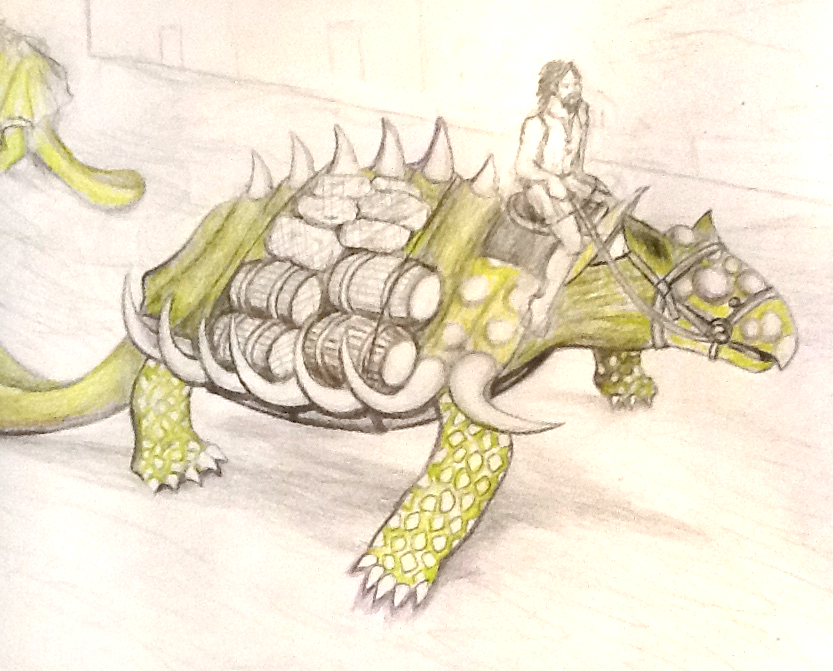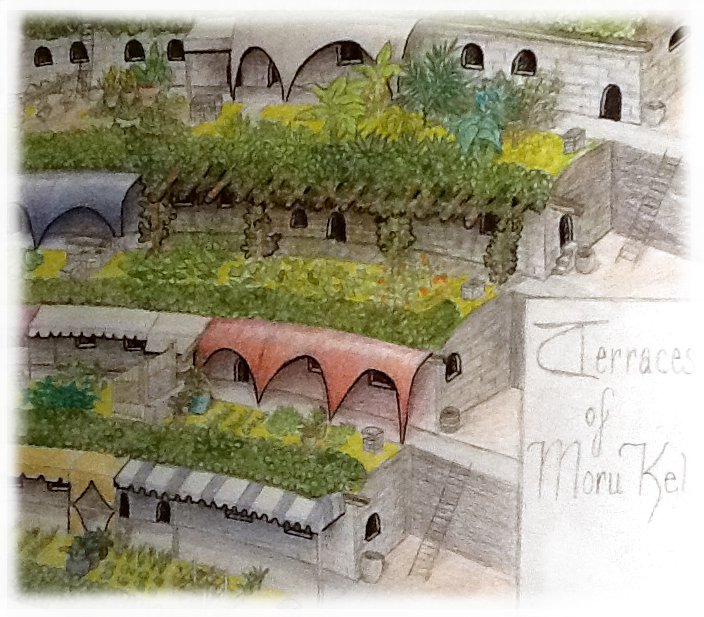Moru Kel, the Terrace City
Two stunning natural 900' spires known as Kernu Apsu (kirnu apsu), “the tusks of the boar,” flank the entrance to the huge, crescent-shaped Kilpo Bay, framing the rising sun. The bay is brimming with ships, many flying colorful flags from their rigging. Smaller boats crowd the waters closest to land. Big, shelled broadbacks, driver
 sastride them, ferry cargo to and from some of the larger ships. The Docks area, always congested, is bursting at the seams now, with the Symposium of Wonders about to start. The trickle of people into the city that started a few months ago has become a torrent. They clog the marketplace at the southern base of the tiers, flowing down from the area around the Symposium grounds and Diamond Lake. Broadback drivers’ yells of “clear now, hutt! hutt!” can be heard above the crowds, as the broadbacks trundle through the Dock district and north along the Cliff Road, past the gleaming new Moon Dome. Three huge Symposium tents abut the Dome, rising nearly as high. A few broadback drivers will head down Captain’s Row to the Warehouses. The majority take the Cliff Road to connect to the wide and winding Slow Road to the west, wending their way up through the seven tiers of Moru Kel.
sastride them, ferry cargo to and from some of the larger ships. The Docks area, always congested, is bursting at the seams now, with the Symposium of Wonders about to start. The trickle of people into the city that started a few months ago has become a torrent. They clog the marketplace at the southern base of the tiers, flowing down from the area around the Symposium grounds and Diamond Lake. Broadback drivers’ yells of “clear now, hutt! hutt!” can be heard above the crowds, as the broadbacks trundle through the Dock district and north along the Cliff Road, past the gleaming new Moon Dome. Three huge Symposium tents abut the Dome, rising nearly as high. A few broadback drivers will head down Captain’s Row to the Warehouses. The majority take the Cliff Road to connect to the wide and winding Slow Road to the west, wending their way up through the seven tiers of Moru Kel.
The Terrace City gets its nickname from the alternating steps of flat land and housing that rise more than 700' above sea level. It owes most of its impressive structure — and infrastructure — to a long-dead civilization, the Urek Empire. The ancient center of the Urek Empire was the city of Skandara. Skandara had lain abandoned for eons, until a ragtag but ambitious collective of lesser nobles and merchants with upward aspirations resurrected it as “Moru Kel” over a century ago. A second nickname, the Garden City, comes from the living roofs planted atop the tiers of stone houses. Those houses, many of which double as businesses, are decorated with awnings and shade sails — both white and brightly colored. Nine stone stairwells lead up through the city, separating the neighborhoods on each tier.  The stairwells are punctuated by large landings, with ornate drinking fountains, mosaics, and statuary from the time of Skandara and the Urek, mostly in pristine condition. Each stairwell features different specific local flora and fauna, making each smaller neighborhood identifiable by those monikers plus information about the tier, like “up in Waterview, about halfway between Briarmouth and Ochala.” The Slow Road is commonly used as part of such directions, and the northernmost areas also use the stations of the newest of the city’s engineering feats — a water-powered funicular — as an identifier. A pet project of the Marghoz, the funicular ferries people up and down the tiers without the meandering of the slow rode or fatigue of the stairwells. During the Symposium rides are free — assuming you can win a ticket in the lottery (the Marghoz does love a good lottery). Marghoz Lango has always been a patron of entertainment, and desire to make his Symposium’s impressive has only intensified those instincts. The city’s puppet shows, theatre events, and wrestling matches are running at peak capacity. Even the children seem to have caught the fever, redoubling their efforts at stairball in the streets.
The stairwells are punctuated by large landings, with ornate drinking fountains, mosaics, and statuary from the time of Skandara and the Urek, mostly in pristine condition. Each stairwell features different specific local flora and fauna, making each smaller neighborhood identifiable by those monikers plus information about the tier, like “up in Waterview, about halfway between Briarmouth and Ochala.” The Slow Road is commonly used as part of such directions, and the northernmost areas also use the stations of the newest of the city’s engineering feats — a water-powered funicular — as an identifier. A pet project of the Marghoz, the funicular ferries people up and down the tiers without the meandering of the slow rode or fatigue of the stairwells. During the Symposium rides are free — assuming you can win a ticket in the lottery (the Marghoz does love a good lottery). Marghoz Lango has always been a patron of entertainment, and desire to make his Symposium’s impressive has only intensified those instincts. The city’s puppet shows, theatre events, and wrestling matches are running at peak capacity. Even the children seem to have caught the fever, redoubling their efforts at stairball in the streets.
Echoing the flags and awnings, kites swirl and hover in the air, swooping like hawks then climbing just as suddenly back into the distance. The kites are a tradition of the local Seta people. Some are kaivars: dancing kites made to look like animals and perform complex tricks. Others are aitvars: fighting kites, plainer in appearance and with strings coated in resin and razor-sharp splinters of volcanic glass. The aitvars charge at each other like birds of prey, as their teams of flyers attempt to sever each other’s strands. Behind them, distant mountains tower over the highest tiers of the city. Cool mountain water runs down to the pair of reservoir lakes atop the city. There, another holdover from the Urek Empire begins: an ancient and complex system of sewers, aquaducts, and drainage pipes unfurls beneath the streets, feeding taps in the housing tiers and irrigating the orchards and farmland. The system also feeds a smaller lake, at the base of the tiers.
Diamond Lake takes its name from this sparkling clear water that feeds it. Looking across it from the Rose Theatre at dawn, the view stretches past Diamond Isle down to the docks, across Kilpo Bay, to the sun rising between the Kernu Apsu. The lake itself is sometimes used as the “stage” for grand productions, pageants and naumachia naumachia? You can just say “naval battles,” showoff. alike. Between the theatre and lake, freestanding homes and businesses thrive. The chatter of old ladies spills from the expansive decks of Sylphia’s Tea Garden out onto the lake as they place bets on the ivory tusks in their hands. The rose stone walls of the Rose Temple of Purnoz gleam a warm pink in the morning light. Temporary accomodations, made to look like brightly painted miniature houses, clutter the sides of the road leading to the Symposium grounds. They were built to hold travellers, but you hear they’re already full to overflowing. People have been camping in the hills beyond the southern farming tiers, and even up into the grazing lands. It’s hard to imagine anyone other than a Runner — well, any Iswari, of course — making the climb down and up to the grazing lands every day. There’s a reason the herders have their huts up there and only rarely come downtown. You don’t have to worry about that, though, because you have a place to stay.
alike. Between the theatre and lake, freestanding homes and businesses thrive. The chatter of old ladies spills from the expansive decks of Sylphia’s Tea Garden out onto the lake as they place bets on the ivory tusks in their hands. The rose stone walls of the Rose Temple of Purnoz gleam a warm pink in the morning light. Temporary accomodations, made to look like brightly painted miniature houses, clutter the sides of the road leading to the Symposium grounds. They were built to hold travellers, but you hear they’re already full to overflowing. People have been camping in the hills beyond the southern farming tiers, and even up into the grazing lands. It’s hard to imagine anyone other than a Runner — well, any Iswari, of course — making the climb down and up to the grazing lands every day. There’s a reason the herders have their huts up there and only rarely come downtown. You don’t have to worry about that, though, because you have a place to stay.
You’ll be on Diamond Isle, where some lucky kids will be spending the Symposium. This was also decided by a lottery system. Surprisingly, there are both rich kids and poor kids; you kinda figured the whole thing was rigged and mostly rich kids would “win” the lottery. It does seem to be favor the wealthy a bit (as tickets have traded hands on the black market), but the Marghoz has tried to make good on his promise to make the Symposium accessible to all walks of life. The Diamond Isle experience will be supervised by counsellors, some of whom aren’t much older than the “campers,” and a mess tent and first aid tent will be present. The Diamond Isle Camp is being run by the Allflock, a religious group that embraces all the deities and places heavy emphasis on doing good in the community.

Technical Notes
We’re going to be starting at level 0, with most of the group 14-15 years old (see the final paragraph above); after a 1-2 session prologue we’ll flash-forward several years to 1st level. You can play an older character to start, but they have to have a reason to be hanging out with a bunch of kids: a camp counseler or something. We’ll have to discuss if you want to do that, and ideally we don’t get 5 people doing so.
At 0-level:
- Stats are 12-12-10-10-10-8, a background, and a race. 6HP, +2 proficiency bonus.
- All kids get away with doing stupid stuff and survive somehow, which means you all get the Lucky feat as kids (you’ll lose it at 1st level).
- Everyone can manifest 1 feat at some point during the prologue. You can choose it on the fly: all of a sudden an innate spellcasting ability shows up (Magic Initiate), or you are super quick (Mobile), or whatever.
At level 1, you lose Lucky but keep your other feat. If you decided to pick a class that basically mimics the feat (Magic Initiate->Wizard, Weapon Mastery->some martial class, etc) then you can pick a different feat instead. I’ll be pretty flexible with this.
So everyone will end up with a bonus feat at 1st level (Note to Dave: a variant human could be Polearm Master/Sentinel at Level 1).
You’ll also move to the standard stat array at 1st level, and can totally re-stat however you want (maybe your fat kid had a growth spurt during puberty and now has high Cha and Str or whatever).
Allowed classes: Any class from the Player’s Handbook, and any official published subclass. As Moru Kel is just moving from the Bronze Age to the Iron Age, artificers are a tough sell unless you are careful to integrate them in a non-steampunk/magi-tech manner (e.g. an Alchemist who’s a potion-maker might be viable).
Allowed races: The most common are: Human, Iswari (mechanically halflings), Mahksi (custom aquatic race), Elf, Dwarf, Half-Elf, Orc, Half-Orc, Goliath
Definitely do exist: Tiefling, Aasimar, Gith, Genasi, Bugbear, Goblin, Shifter. Tieflings, aasimar, and genasi are mechanically unchanged, but descriptively are bloodlines of other races that normally are indistinguishable physically (you might be a human whose bloodline was touched by the gods, or a halfling touched by elemental power), though when racial powers are invoked those may have physical manifestations. Gith have their own lore, so discuss if you’re interested.
Definitely do not exist: Aarakocra, Changeling, Dragonborn, Kenku, Leonin, Lizardfolk, Loxodon, Minotaur, Tabaxi, Tortle, Simic, Warforged, Verdan, Vedalken, Yuan-Ti
Anything else, pitch me on it.
I am allowing the racial customizations from Tasha’s. Most notably, your +X to stats can go wherever you want, so long as you don’t put them both/all into one stat. So a High Elf who’s normally +2 Dex/+1 Int could instead go +2 Con/+1 Wis or +1 Dex/+2 Int, but they couldn’t go +3 Dex or +3 Str.
↞ Previous: Symposium of Wonders Next: Sylphia's Tea Garden ↠